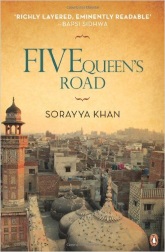Five Queen’s Road
Sorayya Khan

Paperback: 224 pages
|
In 1947 Earl Mountbatten, the last Viceroy of India, signed on the dotted line to give independence to the nation of India and like so many of the British living there, he prepared to pack his bags and head home. The transition from the old administration to the new was not simple. The large red ‘blob’ on the world map which represented the India of Empire days was torn apart by two new lines forming the boundaries between Hindu-majority India and her newly-formed Muslim neighbours, East and West Pakistan. In just a couple of sweeps of a pen, the face of India lost her ‘ears’ in the Partition and tens of millions of people found themselves on the wrong side of the line. Chaos and carnage ensued with millions left dead and many millions more made homeless as they left behind everything they’d built over many generations. The Partition is a strong and oft reworked theme of the literature of the sub-continent but in Sorayya Khan’s novel, Five Queen’s Road, the more typical tale of leaving is replaced with one of the determination of a stubborn man to stay behind in a hostile country. Five Queen’s Road, the eponymous house that forms the nucleus of the book, comes quite subtly to represent the ravaged country of India. Built and owned by John Smithson, an Englishman who’d made his fortune on the Railways, the grand villa stands in the kind of stunning fragrant gardens that only a man with deep pockets and access to a lot of cheap gardeners could aspire to maintain. As he prepares to head back to England, a country that will never satisfy him or fill the gap in his life left by Five Queen’s Road, Smithson turns his thoughts to finding a respectable buyer to take his home at a knock-down price on the condition that the new owner will care for the house and its contents. Dina Lal is the new owner – a Lahori born and bred and not a man to let the small matter of being a Hindu in a newly-formed Muslim land stop him from getting his dream home. Whilst he never cares for it the way Smithson did, he is in his own way just as obsessed with Five Queen’s Road as his predecessor. Whilst Lal is stubborn, he’s not entirely stupid or oblivious to the dangers facing him and so he devises a plan to protect his family. He divides the house he’s just bought into two parts and invites a respectable Muslim widower, Amir Shah, and his family to move into the ‘front house’, whilst he and his family take the ‘back house’. He also converts his religion (much to his wife’s disbelief) to Islam, changing the name at the entrance to his home to D.L. Ahmed. Five Queen’s Road is thus – like India and Pakistan – partitioned. Unlike the countries, the partition of the house starts on friendly terms but it’s not long before the border disputes escalate and the cracks in the house mirror the cracks in Lal and Shah’s arrangement. Each of the two men winds themselves up into increasing rages and resentments, yet beneath the superficial hatred, there’s a strange kind of caring and symbiotic relationship going on. When Lal is stabbed outside his house early in the book, Shah’s son Javid takes him to the hospital for treatment even though his action means that he misses the arrival of his European wife who lands at the airport the very same day. When the wall of Shah’s ‘library’ collapses in a high storm, it’s Lal who throws himself at his neighbour, pushing him out of the way of the falling masonry and saving him from death or injury. Khan’s novel runs from 1947 to 1980 during which time Five Queen’s Road undergoes a steady process of decay, representative some might suggest of the widespread changes across India and Pakistan. You’ll seldom meet an Indian or Pakistani who won’t tell you that things were so much better in the past and the house reflects this sense of entropy in action. The once great gardens are nibbled away as a group of car mechanics set up shop on one of the lawns and a squatter community of ‘sweepers’ expands ever closer towards the house. For most of the characters, the steady decay of Five Queen’s Road and its gardens is a cause of concern and despair but for Irene, the Dutch wife of Amir Shah’s son Javid, it’s a place full of wonder, colour and hope. For her, Lahore represents the culmination of her desire to get as far away as possible from the invaded and desecrated Holland of her childhood. She survived the ‘Die Honger’ Winter in which the German army starved much of the Dutch population with a diet that Victoria Beckam might have considered ‘a bit on the mean side’ in terms of calories, so Lahore seems a wonderful place of warmth and fragrance and the Shah family a fabulous, vibrant substitute for her own lost family. Most of the book is set between 1947 and 1960 which is an unusual period for a novel about the sub-continent. It (just) post-dates Independence but precedes the arrival of the hippies and over-landers in the 1960s and it’s one of those eras when the gap between the post-war austerity of Europe and the post-Independence exuberance of Pakistan probably meant the lifestyle gaps between the two were at their least predictable. As is often the case in a family saga, not very much actually seems to ‘happen’ in Five Queen’s Road. It’s only when you take stock of the desertions, abductions, stabbings, illnesses and feuds that you actually realise that Sorraya Khan has squeezed a lot into her slim novel of just 210 pages. She skips back and forth through time, unpeeling the onion layers of the complex relationships between the Dina Lal and his neighbours. Events take place and you wonder “What’s all that about then?” only to find the cause and effects subtly uncovered in a chapter that follows but is set earlier in the history. Surprisingly it’s not too contrived or difficult to follow this non-linear progression. Khan develops unlikely relationships between her characters showing that each of the two senior protagonists, Lal and Shah, has not lost the ability to love and care as a result of their hatred for each other. Dina Lal and Shah’s son Javid have a relationship more like father and son than Javid has with his own father and Amir Shah’s peaceful enjoyment of his new daughter-in-law’s company goes far beyond his relationship with his own (rather jealous) daughter. Despite their feuding, Khan shows the intrinsic need to love and be loved, to car and be cared for in spite of all a human’s short-comings. It wouldn’t be too much of an exaggeration to say that I will happily read just about any book about 20th century India, especially anything about the Partition, but it would be fair to say that not everything that comes out of the sub-continent sparkles like Five Queen’s Road. I picked my copy up at Bangalore airport as a last minute “Quick, get rid of the rupees, we’re about the board” purchase and I loved every page of this gentle novel with is multi-layered structure. I know nothing about the author but she’s definitely going on my list as a writer to hunt down in future. Unfortunately for most readers though, getting a copy of Five Queen’s Road might prove a bit tricky as it’s not yet released in Europe. But stay patient, put it on your wish list and wait patiently for it to become available – something this good surely most get international release sooner or later. 18 Dec 2009 | Curious Book Fans
|

 Sorayya Khan
Sorayya Khan